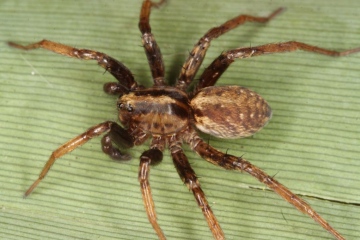Summary for Hygrolycosa rubrofasciata (Araneae)
previous species | next species
National Distribution
Terms of Use. Double-click on map to go to region

Explore Regional Distribution
Please log on and add a note on this species
About this species
Recorded altitude range4m to 37m
Species text
DistributionMost records for H. rubrofasciata are from a small area of West Suffolk, West Norfolk and Cambridgeshire. It has also been recorded from isolated sites in East Suffolk, the New Forest, Hampshire, as well as old records from Sherwood Forest, Nottinghamshire and from Lincolnshire. A record shown in the provisional atlas (Harvey et al. 2002) for TL31 is now considered a data entry error. The species is widespread and fairly common in northern and central Europe, in fens, marshes and damp woodland.
Habitat and ecology
Generally found in damp habitats at ground level, mostly in fens but sometimes under or at the edge of carr woodland by the side of rides. Adults have been found in May, June, September and, at Chippenham Fen (Cambridgeshire) in November (D. Carr, pers. comm.)
Status
This species is abundant at some sites, but very local and restricted in range. It has been recorded from three locations since 1992. There appears to be an ongoing decline in area of occupancy from six hectads before 1992 to three since that date.
Threats
Drainage of fens is the most important threat. However, it appears to be more tolerant of the growth of scrub than most other fenland species.
Management and conservation
Maintaining the water table in fens is very important. Encroachment on open fen by carr woodland is possibly less of a threat to this species than to other typical fenland species, as it occurs widely in wet woodland in Europe.
Text based on Dawson, I.K., Harvey, P.R., Merrett, P. & Russell-Smith, A.R. (in prep.). References
Account last edited by Helen Smith at 09:37 on Tue 19th Jan 2016.
Adult Season
Habitats
background methodology
Recorded management for locations with Hygrolycosa rubrofasciata
Recorded substrate and hydrology for locations with Hygrolycosa rubrofasciata
Images
please log on and upload a new image for this speciesSee also A-Z Species Index - A-Z Picture Index - previous species | next species

